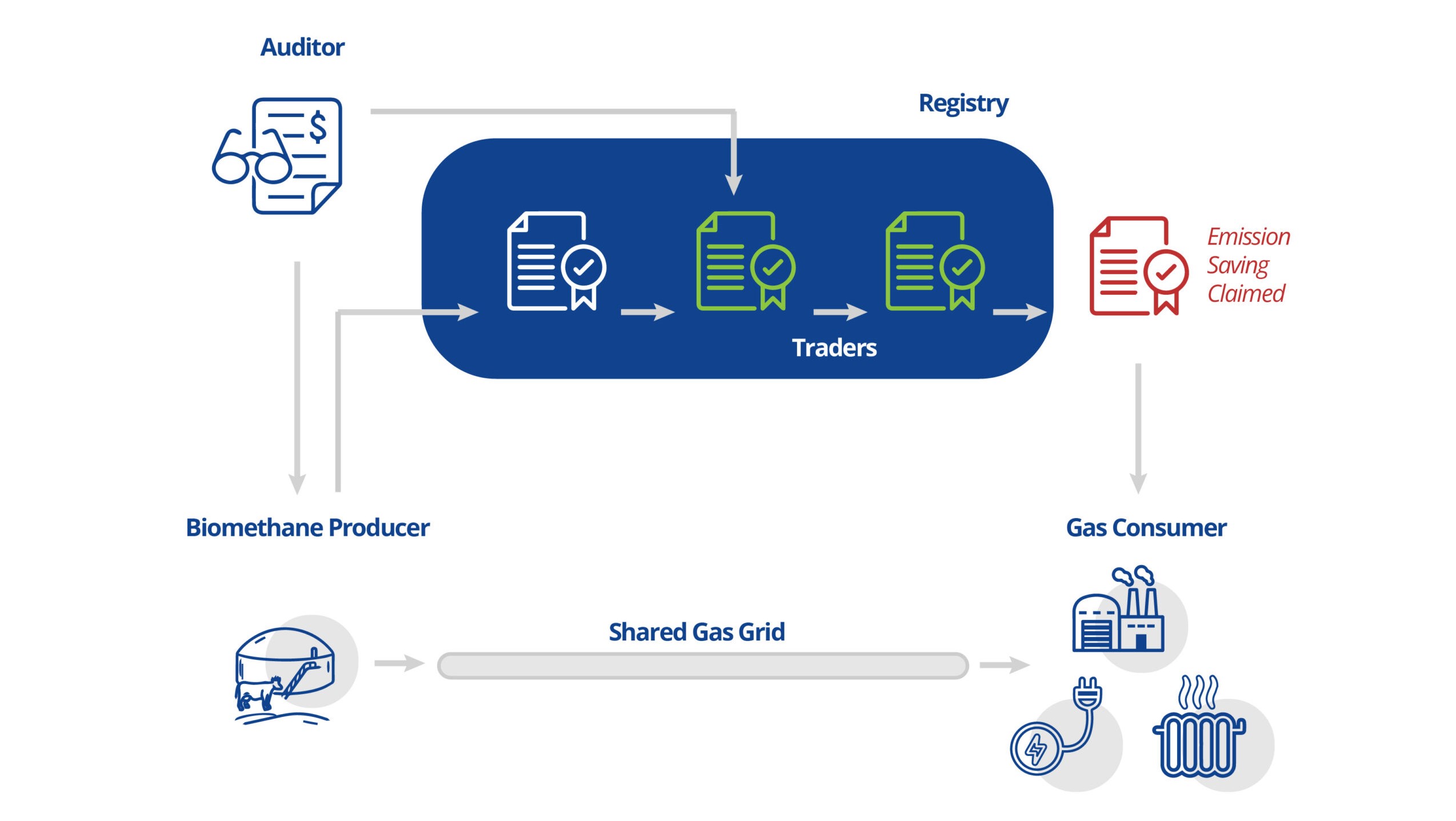Renewable Gas Certificates in the EU – from biomethane to green hydrogen
While addressing scope 2 emission footprints has become more manageable for corporates thanks to readily available solutions, the challenge often lies in tackling scope 1 emissions. In this article, we explore why reducing scope 1 emissions poses a significant obstacle for corporates and present the biomethane solutions that offer a viable – and impactful – alternative.
Key obstacles for corporates tackling scope 1 emissions reduction
Not surprisingly, many corporates choose emissions compensation over reduction due to the challenges frequently encountered in efforts to reduce emissions. These obstacles include:
- Limited availability of technically feasible renewable alternatives
- Challenging business cases in terms of existing alternatives
- Implementation complexity due to process path dependencies
Though renewable solutions for are still very limited – exacerbated by the wait on green hydrogen – biomethane poses a viable alternative as it can be used as an interim solution to substitute natural gas
Biomethane: understanding the basics
Biomethane is produced by upgrading biogas and feeding it into existing gas pipelines. There are two sourcing options for biomethane; it can be bundled as a biomethane supply contract, either through a direct pipeline or via the gas grid, or the renewable claim can be acquired as unbundled biomethane certificates.
The EU Renewable Energy Directive (RED) II mandates stringent standards for certificates related to renewable gases like biomethane and green hydrogen, similar to that of renewable electricity. EU members are progressively establishing national registries for renewable gases, and though the pan-European scheme (ERGaR) awaits official EU commission recognition, corporates in countries with existing registries can already source biomethane certificates nationally or even cross-border. So far these registries are only available for a few European countries and are often facilitated through brokers. This allows corporates with connection to the same interconnected gas grid to “green” (at least part of) their natural gas consumption.

How Biomethanes Certificates Work
Did you know?
Similar certification schemes, as Europe, are already established in the UK and the US for biomethane claims.
At a glance: benefits and challenges of biomethane for corporates
Benefits
- Increased ambition: enables an absolute reduction (not just compensation) of scope 1 emissions, aiding businesses to close the gap to target.
- Enhanced credibility: allows businesses to demonstrate a commitment to addressing Scope 1 challenges.
- Seamless integration: no changes needed to current gas-fired processes or equipment.
- Potential EU-ETS benefits: offers a chance to reduce exposure to the European Union Emissions Trading System.
Challenges
- Access to certificates: there is a limited availability of certificates due to the limited sources of biomethane. Even with potentially new biomethane plants going online in the future, the generated certificates are only available in a few regions and do not represent a blueprint instrument to cover large natural gas volumes.
- High price volatility: businesses always incur an additional cost, currently ranging from 5 €/MWh to high double-digit prices depending on the country.[1]
- Uncertainty around reduction claims: it has still not been confirmed whether biomethane certificates will be accepted by the Greenhouse Gas Protocol and CDP as a scope 1 instrument. As it currently stands, the GHG Protocol does not issue specific guidance on the use of biomethane certificates[2] so that corporates can decide for themselves whether to use them for emission reduction claims.
- Sustainable feedstock: for biomethane production either residual biomass (e.g. manure, food waste) or dedicated crops (e.g. corn, sugar cane) can be used. Given the controversy regarding energy crops and the use of farmland for food vs. fuel discussion, it is recommended that corporates set specific requirements for the origin of the feedstock when sourcing biomethane certificates.
Outlook and recommendations
Amid the development of a dedicated hydrogen grid and a free market for hydrogen in Europe, new certification schemes (such as CertiHy [3]) that are currently being developed in line with the Renewable Energy Directive II are now even more crucial for credible renewable gas claims.
Despite green hydrogen’s emerging status, future H2 off-takers, particularly in hard-to-abate sectors (such as steel, glass and ceramics, and cement), should keep an eye on the regulatory developments, and anticipate that they will have to source green hydrogen from a mixed pipeline of green and conventional hydrogen in the early stages.
Due to the limited market and high costs, biomethane certificates are not a standard solution for every company, but can be an important interim instrument for those under pressure to act on their decarbonization goals. We recommend incorporating the sourcing of biomethane certificates into a comprehensive strategic framework, still placing emphasis on the electrification of processes and reducing reliance on fossil fuels.
Where to start?
Renewable gas certificates are gaining traction, both within the European Union and globally. They are poised to be increasingly relevant with the forecasted uptick in green hydrogen adoption and thus, now is the time for corporates to:
- Understand whether biomethane certificates fit the overall decarbonization strategy and how to source them efficiently.
- Understand the implications of the emerging green hydrogen economy on the business.
- Understand how their business is affected by the latest regulatory developments and the opportunities that arise from them, whilst ensuring compliance with GHG Protocol, SBT, and CDP.
Looking to engage tailored advice or support? Connect with our team to learn more.
get in touch
Want to know more? Reach out to the team for support in accelerating the corporate renewable energy transition: contact@actrenewable.net

